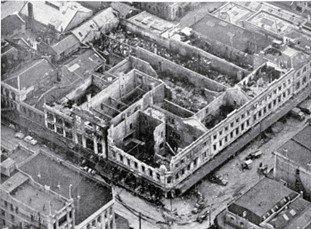
Profit versus Life
On 18 November 1947 the worst fire in New Zealand history broke out; the Ballantynes Fire. Some crucial facts from this that are still relevant today:
• Eight different buildings, all connected with one another
• Openings had been cut through walls between the buildings without permits from the city council. Few of those openings could be sealed off when needed in the event of a fire
• The shop had scarcely any fire doors so the fire wasn’t contained
• Staircases were open to draughts feeding the fire (like a chimney)
• Lifts were open, or enclosed with flammable panels
• Alarms installed and twice had been removed by the security firm which fitted them, because inspectors felt that Ballantynes neglected to maintain the system
• Management, having had the place measured up for a sprinkler system earlier in the year, had decided to turn down the quote
• Ballantynes though required by the Factories Act to provide escape for every workroom on the upper floors, had never fulfilled their requirement
• The cellar; one of six basements beneath the building contained closely packed stores of folding furniture, rolls of carpet, bolts of various cloth together with tins of naphthalene and cans of cleaning fluid etc for cleaning
• An electrical cable crossed the full length of this subterranean space meaning fire cells were compromised
• Early on staff in the showroom were ordered to cover stock with calico sheets, but no instructions for evacuation were issued
• Fire doors were drawn across two archways in an attempt to confine smoke to one part of the store, but fumes forced their way upwards through unseen cavities
• The smoking cellar was connected with three other basements, creating a powerful draught along the entire length of the Colombo Street
• The occupants of the upper floors of the building were jovial about the alarms from the street below as the workers (mostly women) were ordered back to work
• After over half and hour from first signs of smoke some customers were been evacuated the building, however for the rest it was business as usual
• The officer in command of the force, was not allowed under law (at that time) to enter a burning building without permission from its owners
• When Roger Ballantyne led the fire chief into the building, he wasted several minutes in an unsuccessful attempt to find a way down a goods lift at the back of the building instead of using the stairwell
• By the time flames were seen one of the fire escapes was compromised
• Some heads of departments made the decision themselves to evacuate their staff from the upper floors of the building
• Witness commented that “It was pitch dark on the stairs” and “… couldn’t get my footing. The blackness. I was in the middle, crowded in, with elbows on both sides of me, and couldn’t get hold of a railing”
• Sadly, Fire-fighters could not save those who had found themselves trapped on the third and fourth floors as their ladders could not reach the upper windows, impeded by the buildings veranda
• The building was unsafe and did not meet city building regulations, although it had been inspected and passed four years earlier
Disasters like this are heart-breaking, especially since they could have been avoided. Even more shocking, is this still continues to be the trend today where fire safety (active of passive) is given low priority over prevention.
